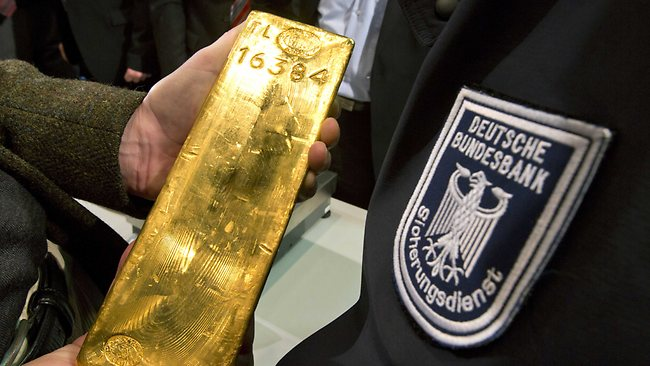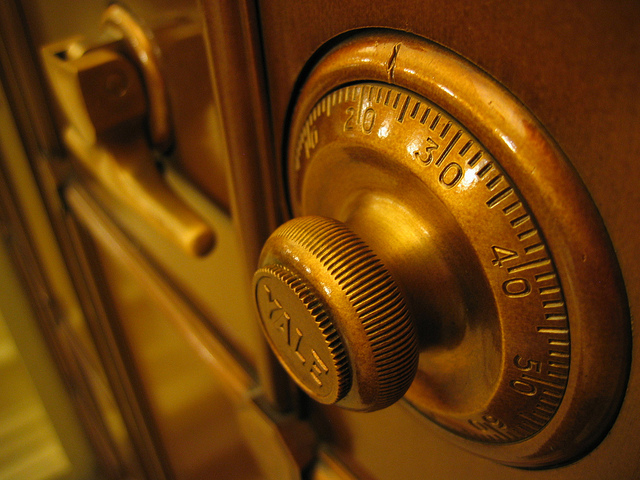– ‘Availability of gold strengthens public confidence in the central bank’s balance sheet’ say Bundesbank
– Bundesbank has Audited Reserves amounting to almost 3,400 tonnes, around 68% of Bundesbank’s reserve assets
– Bank taken series of steps to increase transparency around Germany’s gold holdings
– Germany has second largest gold holdings in the world; U.S. believed to be largest
– Transparency important and all central banks should follow the Bundesbank lead
Editor: Mark O’Byrne
Germany’s central bank serves as an example to central banks when it comes to respecting gold reserves and the public’s knowledge of them. The Bundesbank has worked incredibly hard in recent years to be transparent in regard to its gold bullion reserves.
The latest edition of Gold Investor from the World Gold Council has a very interesting article written by Carl-Ludwig Thiele, Member of the executive board of the Bundesbank which we bring to you below. In it Thiele outlines the reasoning of the Bundesbank to be open and transparent about the 3,373.6 tonnes of gold that represents nearly 70% of the country’s reserves.
There are two significant lessons to be learnt here – one for central banks and one for individual investors. The first is, central banks should be aware of the benefits of gold and how transparency will boost the public’s confidence. The second is investors should understand why the Bundesbank is so interested in protecting its gold bullion.
Gold cannot be devalued as the euro, dollar, sterling and all fiat currencies are being and will be. It cannot be confiscated a la deposits in bank bail-ins and it is extremely difficult to confiscate gold coins and bars if owned in allocated and segregated storage in safe vaults in the safest jurisdictions in the world. It is a borderless money that acts as the ultimate reserve and safe haven in a diversified portfolio.
From Gold Investor:
At the Bundesbank, we are tasked with ensuring price stability and have a variety of monetary policy tools to deliver it. We do, however, have another vital tool at our disposal: our word. As an independent body, free from political influence we have gained public confidence and our word is implicitly trusted.
Confidence, once gained, is priceless. Just like a currency, this confidence must be continually reinforced, and the Bundesbank has always fought for just that – through words, argument and, increasingly, transparency, particularly in relation to our gold holdings.
Germany’s gold reserves were largely accumulated between the 1950s and the early 1970s, when the country experienced rapid economic growth and developed a substantial current account surplus. Initially, the gold remained in its original locations, stored in central banks around the world.
Today, our gold reserves are held in three locations: the Deutsche Bundesbank in Frankfurt am Main, the Federal Reserve Bank in New York and the Bank of England in London. The storage facilities at these sites satisfy a number of essential criteria, including cost efficiency, the ability to liquidate the reserves at short notice and security, which is particularly high at all three locations.
Transporting several hundred tonnes of gold is a complex task and the decision to proceed took careful thought. Following the financial and euro crisis, general awareness of gold as an investment has risen considerably. As a result, interest in the Bundesbank’s gold reserves has increased markedly, among policymakers, the Federal Court of Auditors and the public at large. The overwhelming response to the Bank’s open days in 2014 and 2017 underlined this fascination, when individual visitors queued for up to two hours just for the chance to hold a gold bar in their hands.
Against this background, the Bundesbank was increasingly questioned about the location, security and availability of Germany’s gold. As a direct result, our Executive Board resolved to become more transparent about the reserves and to relocate them…
As a first step, the responsible Executive Board member broke with established practice and, in the autumn of 2012, disclosed the exact volumes of gold held at each storage location. That was when the Board opted to relocate a substantial proportion of this gold to Germany. The public was informed of this decision at a press conference on 16 January 2013. A number of gold bars were on display, several of the Bank’s verification processes were demonstrated and the Bundesbank announced that it would start to relocate 674 tonnes of gold, held in vaults at the Federal Reserve Bank in New York and the Banque de France in Paris. By 2020 at the latest, just over 50% of Germany’s gold reserves were to be stored in Frankfurt.
The decision to transfer the gold was prompted by a number of factors: a desire to increase confidence among the German public; changes in geopolitical circumstances – such as the fall of the Iron Curtain – and the fact that the Bundesbank had available storage capacity in Frankfurt. In this context, it is important to note that, up until 1997, the Bundesbank stored only 77 tonnes of gold in Frankfurt.
In a second step towards increasing transparency, at the beginning of 2014, the public was informed of the previous year’s transfers and, in February 2017, we announced that the transfer of gold from the Federal Reserve Bank in New York had been successfully completed. Six months later, we revealed that the transfers from the Banque de France in Paris had been completed too. At press conferences held to unveil these developments, journalists were given an up-close look at some of the gold bars that had been brought to Frankfurt from both New York and Paris.
In a third step towards increasing transparency, the Bundesbank Executive Board commissioned a film on the transfer and storage of Germany’s gold, released in 2015.
As another milestone and a global first, an additional fourth step towards increasing transparency was taken with the publication of a list of all German gold bars, totalling around 270,000 in number. The Bundesbank has now published this roughly 2,400-page list three times since October 2015, even though it involved a series of significant challenges. There is no ‘blueprint’ for inventory lists of gold holdings and, in 2015, virtually no central bank in the world had ever released such a list.
“The devil is in the detail” – as they say – and we had to focus painstakingly on the detail to draw up the gold bar inventory list. During this time-consuming process, one thing became clear: rules are very helpful in making transparency a reality. The London Bullion Market Association (LBMA) offers an appropriate set of rules. Elsewhere however, there is little consistency. Even though various online gold forums claim that there is a ‘standard’ for gold bar inventory lists, determined by the LBMA, this only relates to commercial weight lists for gold deliveries to storage facilities in London.
Looking back, the transparency campaign has taught us a number of useful lessons.
First, the availability of reserve assets like gold strengthens public confidence in the stability of a central bank’s balance sheet. As at 31 December 2016, gold holdings made up around 68% of the Bundesbank’s reserve assets. This has a significant impact on public perception so it is essential that we constantly maintain and develop a relationship of trust with the general public. This was and continues to be the primary goal of our transparency campaign.
However, making transparency a reality requires both time and human resources. Over the past five years, our dialogue with both the general public and policymakers on the topic of the Bank’s gold reserves has intensified considerably. Experts, politicians and citizens increasingly appreciate our openness around Germany’s gold reserves but it takes time to answer everyone’s questions, however legitimate they are. In the Money Museum, which reopened at the end of 2016, the Bank also offers visitors the opportunity to handle a gold bar for themselves. This gold bar (400 oz) is no larger than a one-litre carton of milk, but weighs roughly 12.5kg and is worth more than €400,000.
There is one question that we cannot answer, even though it has been asked time and again: what routes and means of transport were used for the gold transfers? In this matter, as in cash transport, the security of staff and assets always takes precedence over the need for information and transparency. For this reason, the Bundesbank has consistently refused to answer any such questions, and will continue to do so in the future.
Ultimately, it is evident that central banks, with their more ‘sober’ attitude towards gold, can help to rationalise the discussion about gold. But we can do this most effectively by reinforcing our position as trusted authorities towards the general public – and that is best achieved by taking appropriate steps towards increased transparency.
‘Transparency – at least as valuable as gold’. Gold Investor, December 2017
Related reading
Gold Investment In Germany Surges – Now World’s Largest Gold Buyers
“Delivery Of Gold” Refused By Gold Exchange Traded Commodity In Germany
Uncertain Times Sees Germany Repatriate 200 Tonnes Of Gold Bullion
News and Commentary
Bitcoin Heads to Bigger Wall Street Stage as CME Debuts Futures (Bloomberg.com)
Bitcoin Hits New All-Time High At $19,659.50 (GoldSeek.com)
The EU has signed a deal to integrate 23 armies (WeForum.org)
PRECIOUS-Gold prices edge down amid firmer dollar, equities (Reuters.com)
Bitcoin explosion highlights gold price suppression (Gata.org)
Silk Road Fever Grips The Russian Far East And Boosts Economy (ZeroHedge.com)
Why 2017 Was a Year to Celebrate (GoldSeek.com)
Gold Prices (LBMA AM)
18 Dec: USD 1,258.65, GBP 943.11 & EUR 1,067.71 per ounce
15 Dec: USD 1,257.25, GBP 937.41 & EUR 1,065.52 per ounce
14 Dec: USD 1,255.60, GBP 935.67 & EUR 1,062.49 per ounce
13 Dec: USD 1,241.60, GBP 929.96 & EUR 1,056.97 per ounce
12 Dec: USD 1,243.40, GBP 933.92 & EUR 1,056.27 per ounce
11 Dec: USD 1,251.40, GBP 935.80 & EUR 1,061.19 per ounce
08 Dec: USD 1,245.85, GBP 924.42 & EUR 1,061.09 per ounce
Silver Prices (LBMA)
18 Dec: USD 16.09, GBP 12.04 & EUR 13.64 per ounce
15 Dec: USD 15.99, GBP 11.93 & EUR 13.55 per ounce
14 Dec: USD 16.01, GBP 11.92 & EUR 13.54 per ounce
13 Dec: USD 15.71, GBP 11.76 & EUR 13.38 per ounce
12 Dec: USD 15.78, GBP 11.82 & EUR 13.40 per ounce
11 Dec: USD 15.84, GBP 11.84 & EUR 13.43 per ounce
08 Dec: USD 15.83, GBP 11.76 & EUR 13.48 per ounce
Recent Market Updates
– WGC: 2018 Set To Be A Positive Year For Price of Gold and Investors
– Year-end Rate Hike Once Again Proves To Be Launchpad For Gold Price
– UK Stagflation Risk As Inflation Hits 3.1% and House Prices Fall
– Buy Gold, Silver Time After Speculators Reduce Longs and Banks Reduce Shorts
– Bitcoin – Plan Your Exit Strategy Now – Maybe With Gold
– Gold Demand Increases Along with Uncertainty Thanks to Trump, Brexit and North Korea
– UK Pensions Risk – Time to Rebalance and Allocate to Cash and Gold
– Bailins Coming In EU – 114 Italian Banks Have NP Loans Exceeding Tangible Assets
– Silver’s Positive Fundamentals Due To Strong Demand In Key Growth Industries
– An Interview with GoldCore Founder, Mark O’Byrne
– Low Cost Gold In The Age Of QE, AI, Trump and War
– Own Gold Bullion To “Support National Security” – Russian Central Bank
– Bitcoin $10,000 – Huge Volatility of Cryptocurrencies and Risky Fiat Making Gold Attractive
Important Guides
For your perusal, below are our most popular guides in 2017:
Essential Guide To Storing Gold In Switzerland
Essential Guide To Storing Gold In Singapore
Essential Guide to Tax Free Gold Sovereigns (UK)
Please share our research with family, friends and colleagues who you think would benefit from being informed by it.
The post ‘Gold Strengthens Public Confidence In The Central Bank’ – Bundesbank appeared first on GoldCore Gold Bullion Dealer.
![]()





Leave A Comment
You must be logged in to post a comment.